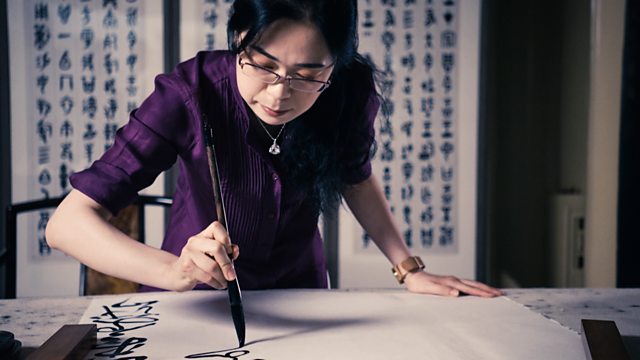The Secret History of Writing episode 2: In 1448, in Mainz, Germany, a goldsmith named Johannes Gutenberg was experimenting with a lead alloy and a hand-held mould. His aim was to speed up the process of putting ink on paper. But what he did was speed up history. Gutenberg’s printing press spelled the end of the Middle Ages and ushered in the modern world of science and industry. Every innovation since has been built on this foundation. Yet behind Gutenberg’s invention lay centuries of development and change in the way words were written, without which he could never have succeeded. In this film, presenter Lydia Wilson and calligrapher Brody Neuenschwander set out to explore history’s most important technology – the technology of putting words on a page.
Writing itself is 5,000 years old, and for most of that time words were written by hand using a variety of tools. As a calligrapher, Brody can still use those tools in a form of experimental historical research. The insights gained in this way reveal how the changing methods people used to create written texts helped to change the course of history.
Arguably, the history of writing begins in Egypt. The ancient Egyptians created the world’s first nation state, and they ran it with the help of one of the very earliest writing systems: hieroglyphs. Today, hieroglyphs can still be read in monumental inscriptions carved in stone. But, the Egyptians also had a portable, everyday medium on which to write: papyrus.
Papyrus is a type of sedge that grows all along the banks of the Nile. Readily available and easily harvested, this unassuming plant was turned by the Egyptians into one of the foundations of civilisation: the papyrus scroll. And as civilisation spread from Egypt across the Mediterranean world, so did papyrus. The Romans were able to run an empire thanks to documents written on papyrus, and when they conquered Egypt in 30 BC, one of the biggest prizes of conquest was domination of the Mediterranean papyrus trade.
Brody’s experiments with a reed pen and a papyrus scroll reveal just what an efficient combination they are for the rapid production of written text. That meant that scroll books could be made quite cheaply, and Roman bookshops could sell one for as little as one denarius, a soldier’s daily wage. As a result, ancient Rome had a thriving literary culture.
But, by the end of the third century, Rome’s control over the Mediterranean had begun to slip. Papyrus became more and more difficult to obtain, and Roman book production plummeted. Europeans were forced to turn to a much more expensive surface on which to write: parchment. From being a relatively affordable and available commodity, books would become rare and costly. The fall of the Roman Empire and the onset of the European Middle Ages coincides with this shift from papyrus to parchment.
The Secret History of Writing episode 2
Medieval handwritten books, with their sumptuous illuminations, represent a pinnacle of medieval art, but since a large book could cost as much as a house, they also represent a limitation on literacy and scholarship.
No such limitations were felt in China, where paper had been invented in the second century. Paper was the foundation of Chinese culture and power, and for centuries how to make it was kept secret. But, in 751 AD, the westward expansion of the Tang Dynasty was checked by Arab forces at the River Talas. It was a defeat which ensured that, to this day, central Asia would be part of the Muslim world. And in the captured baggage train of the Chinese army there were paper-makers. The secret was out, and paper mills soon sprang up across central Asia.
The result was an intellectual flourishing known as the Islamic Golden Age. Muslim scholars made discoveries in biology, geology, astronomy and especially mathematics. By contrast, Europe was an intellectual backwater.
That changed with Gutenberg’s development of movable type printing. The secret of Gutenberg’s printing press was his ability to mass-produce multiple copies in metal of each individual letter. And in this he had a hidden advantage: the letters of the Latin alphabet are very simple block-like shapes, which made it relatively simple to turn them into type pieces.
On the other hand, when printers tried to use movable type to print Arabic texts, they found themselves hampered by the cursive nature of Arabic writing, where the letters of a word often join together to form one single flowing shape. It was more than two hundred years before the first Arabic print shop was established in the Muslim world, in 1727 in Istanbul.
The success of movable type printing in Europe led to a thousand-fold increase in the availability of information, an explosion of ideas that led directly to the European Scientific Revolution and the Industrial Revolution that followed. That these developments began in Europe is one of the most important facts that shapes the world we live in today, and it is down in part to the simple accident of the shape of the Latin alphabet.




